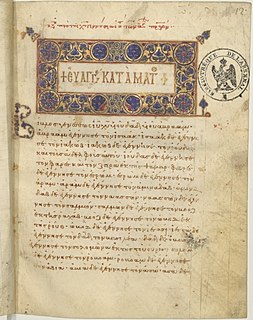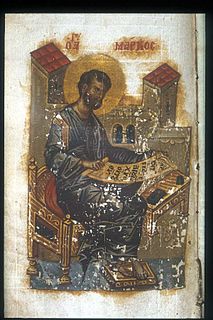Related Research Articles
Minuscule 7, ε 287, is a Greek minuscule manuscript of the New Testament, on parchment. Palaeographically it has been assigned to the 12th century.
Minuscule 12 (in the Gregory-Aland numbering), A137 (Von Soden), is a Greek minuscule manuscript of the New Testament, on parchment, dated palaeographically to the 14th-century.
Minuscule 34 (in the Gregory-Aland numbering), A19 (Von Soden). It is a Greek minuscule manuscript of the New Testament, written on vellum. Palaeographically it has been assigned to the 10th century.
Minuscule 36 (in the Gregory-Aland numbering), A20 (von Soden). It is a Greek minuscule manuscript of the New Testament, written on vellum. Paleographically it has been assigned to the 12th century. It has complex contents and full marginalia.
Minuscule 38, δ 355. It is a Greek minuscule manuscript of the New Testament, written on vellum. Palaeographically it has been assigned to the 12th century. Formerly it was labelled by 38e, 19a, 377p. The manuscript is lacunose. It has marginalia.
Minuscule 40 (in the Gregory-Aland numbering), A155 (Von Soden) is a Greek minuscule manuscript of the New Testament. Paleographically it has been assigned to the 11th century. It is written on vellum and has marginalia.

Minuscule 43, α 270 and ε 170, is a Greek minuscule manuscript of the New Testament, on parchment leaves. Palaeographically it has been assigned to the 11th century. Gregory suggested the 12th century. It has full marginalia.

Minuscule 46, ε 1285, is a Greek minuscule manuscript of the New Testament, on parchment leaves. Paleographically it has been assigned to the 13th century. It has complex contents and full marginalia.
Minuscule 48 (in the Gregory-Aland numbering), A232 (von Soden), is a Greek minuscule manuscript of the New Testament, on parchment leaves. Palaeographically it has been assigned to the 12th century. It has complex contents with some marginalia.
Minuscule 49, ε 155, is a Greek minuscule manuscript of the New Testament, on parchment leaves. Paleographically it has been assigned to the 12th century. It has complex contents and full marginalia.
Minuscule 50 (in the Gregory-Aland numbering), A232 (von Soden), is a Greek minuscule manuscript of the New Testament, on parchment leaves. Palaeographically it has been assigned to the 11th century. The manuscript has survived incomplete.
Minuscule 52, ε 345, is a Greek minuscule manuscript of the New Testament, on parchment leaves. The codex was written in 1285 or 1286. It has complex contents and full marginalia.
Minuscule 75, ε 176, known as Codex Genevensis, is a Greek minuscule manuscript of the New Testament, on parchment leaves. Palaeographically it has been assigned to the 11th century. The codex has complex contents. It was adapted for liturgical use. It has complex contents, and full marginalia.
Minuscule 95 (in the Gregory-Aland numbering), A212 (von Soden), is a Greek minuscule manuscript of the New Testament, on parchment leaves. Palaeographically it has been assigned to the 12th century. It has marginalia.
Minuscule 98, ε 266, is a Greek minuscule manuscript of the New Testament, on parchment leaves. Palaeographically it has been assigned to the 11th century. It has marginalia, it was adapted for liturgical use.
Minuscule 100 (in the Gregory-Aland numbering), A11 (von Soden), is a Greek minuscule manuscript of the New Testament, on parchment. Palaeographically it has been assigned to the 10th century. The manuscript has complex contents and full marginalia.
Minuscule 107, ε 344 (Soden), is a Greek minuscule manuscript of the New Testament, on parchment leaves. Palaeographically it has been assigned to the 13th century.
Minuscule 109, ε 431 (Soden), is a Greek minuscule manuscript of the New Testament, on parchment leaves. It is dated by a colophon to the year 1326. The manuscript has complex contents.
Minuscule 775, ε461, is a Greek minuscule manuscript of the New Testament written on parchment. Palaeographically it has been assigned to the 13th century. The manuscript has complex contents.
Minuscule 899 is a Greek minuscule manuscript of the New Testament, on parchment. Palaeographically it has been assigned to the 11th century.
References
- ↑ Gregory, Caspar René (1908). Die griechischen Handschriften des Neuen Testament. Leipzig: J. C. Hinrichs'sche Buchhandlung. p. 49.
- 1 2 3 K. Aland, M. Welte, B. Köster, K. Junack, "Kurzgefasste Liste der griechischen Handschriften des Neues Testaments", Walter de Gruyter , Berlin, New York 1994, p. 49.
- 1 2 "Liste Handschriften". Münster: Institute for New Testament Textual Research. Retrieved 2014-10-19.
- 1 2 3 4 5 Gregory, Caspar René (1900). Textkritik des Neuen Testamentes. 1. Leipzig: J.C. Hinrichs. p. 137.
- ↑ Scrivener, Frederick Henry Ambrose; Edward Miller (1894). A Plain Introduction to the Criticism of the New Testament . 1 (4 ed.). London: George Bell & Sons. p. 196.
- ↑ Aland, Kurt; Aland, Barbara (1995). The Text of the New Testament: An Introduction to the Critical Editions and to the Theory and Practice of Modern Textual Criticism. Erroll F. Rhodes (trans.). Grand Rapids: William B. Eerdmans Publishing Company. p. 138. ISBN 978-0-8028-4098-1.
- ↑ Wisse, Frederik (1982). The Profile Method for the Classification and Evaluation of Manuscript Evidence, as Applied to the Continuous Greek Text of the Gospel of Luke . Grand Rapids: William B. Eerdmans Publishing Company. p. 53. ISBN 0-8028-1918-4.
- ↑ Bruce M. Metzger, The Early Versions of the New Testament: Their Origin, Transmission and Limitations, Clarendon Press: Oxford 1977, p. 136.
- ↑ Philip Comfort, The Text of the Earliest New Testament Greek Manuscripts (2001), p. 551.
- ↑ Jean-Pierre-Paul Martin, Description technique des manuscrits grecs, relatif au Nouveau Testament, conservé dans les bibliothèques des Paris (Paris 1883), p. 47